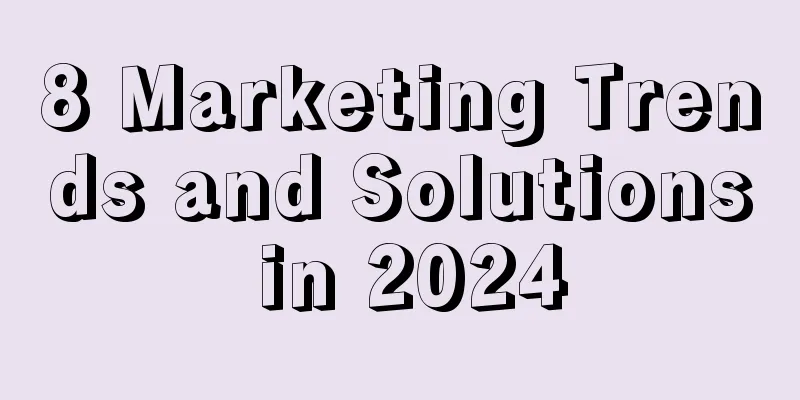How can marketers master AI to avoid being eliminated?

Since ChatGPT became popular in recent months, I believe that most marketing practitioners have gained a certain understanding of AIGC. Many people have even begun to use AI tools to assist in completing their work and improve work efficiency. Of course, some people also think that this AI trend is just like the previous concepts such as metaverse and blockchain, and will fade away after the novelty wears off. However, I think AI is fundamentally different from those concepts. AI has a wide range of application scenarios and strong universality, and can bring substantial help to people's lives and work. It is an absolute rigid demand and not a hyped concept. It can even be said that all industries can be redone with AI in the future. This is also why ChatGPT was able to exceed 100 million monthly active users within 2 months, becoming the fastest growing application in human history. This shows that the breakthrough in AI technology has brought extraordinary shock and appeal to people. 1. What can marketers do with AI?For marketing practitioners who need to keep up with market changes and use innovation and creation as their core competitiveness, actively embracing AI and learning to use AI tools is an inevitable trend. So in our daily work, what specific marketing tasks can we complete with the assistance of AI? 1. Market research and data analysisAI tools can quickly collect and organize market information and user feedback, helping marketing practitioners understand user needs, market competition and development trends. For example, in the past, to gain insight into user needs, you had to first collect a large amount of data and reports, and then spend time digesting and organizing some truly useful information; if you happened to encounter an unfamiliar field, it usually took more than a day to conduct research and analysis. The use of AI can skip the steps of collection, organization and digestion, and directly obtain the required insights and conclusions, which is faster and more comprehensive. AI can also be used as an assistant to analyze data. It can process large amounts of advertising data at the same time, analyze and mine advertising data, help evaluate and predict advertising effects, user behavior, and market trends, etc. It can discover hidden insights from the data and guide the optimization of advertising strategies and decision-making. 2. Marketing and advertising managementFirst of all, in terms of advertising, AI tools can help automatically select the best advertising channels, time and audience targeting based on consumer characteristics, behaviors and feedback data, to achieve intelligent advertising and bidding; they can also monitor advertising effects in real time, make real-time adjustments and optimizations to improve advertising conversion rates and return on investment. It can also help manage brand public opinion. AI tools can monitor and analyze brand reputation, user comments and trends on social media platforms. By monitoring and analyzing brand reputation, user comments and sentiment on social media platforms, it can help marketing practitioners understand consumer feedback in a timely manner, conduct brand management and formulate social media marketing strategies. 3. Advertising creativity and content generationThe generation of creative content is definitely the scenario where marketers use AI tools the most. They only need to clearly give their brief to AI, and they can quickly generate rich and diverse content and creativity, such as advertising copy, video scripts, social platform content, advertising visual creativity, etc. Of course, if you want to get high-quality content, you can’t just sit back and enjoy the results. Human control and intervention are indispensable. First of all, the level of questioning directly determines whether AI can generate correct content according to needs. In addition, the content generated by AI needs to be further organized and optimized manually; therefore, to make good use of AI tools, users are also required to have strong professional knowledge and become the masters of AI tools rather than followers. 4. Intelligent customer interactionIntelligent customer service itself is already a relatively mature and popular technology. However, with the support of large models, the capabilities of AI intelligent customer service have also been qualitatively improved. Through natural language processing and machine learning, it provides users with faster and more accurate answers to questions, meets customers' personalized service needs, and thus improves customer satisfaction and experience. The above are some of the tasks that use AI relatively frequently in daily marketing work; and the actual application scenarios are far more than these. Writing weekly reports, making plans, searching for information, writing press releases, and even replying to emails can all be done with AI. Therefore, you must make AI your powerful personalized assistant. Skillful control of AI will enable you to achieve a qualitative leap in your work efficiency. 2. What preparations should marketers and companies make?Do marketers need to learn how to use AI right away? What can marketing companies do to help their employees? The answer to this question is obvious. Regardless of the type of marketing company, using AI tools can greatly improve employee efficiency. In a less optimistic environment, using AI as a daily assistant is a perfect way to reduce costs and increase efficiency. For the helmsman of a marketing company, a very important task is to lead all employees to actively embrace AI: first, let employees realize the value and help of AI in their daily work from a conscious level. AI is a very powerful and efficient assistant in daily work. Secondly, at the action level, employees should be encouraged to use and explore AI tools, and even spend more money to train employees on the use of AI. Another question that needs to be considered is "Do marketing companies need to develop their own AI tools?" This can be considered comprehensively based on the company's business type, existing capabilities and resources, and the size of the company. For companies whose businesses are mainly digital marketing, have their own technical departments, and have a relatively large business volume, it is imperative to develop their own AI tools, which can help complete the management and optimization of advertising, conduct data analysis and insights, generate and optimize advertising ideas, etc., reducing labor costs while improving advertising efficiency. For advertising companies that do not have technical personnel, are small in scale, and do not have sufficient funds and resources, they do not have to blindly invest a lot of resources to develop AI tools. They can buy easy-to-use AI tools in the marketing and advertising fields on the market and use them first, and then make plans when there is a suitable opportunity. In short, whether a company should develop its own AI tools can be decided based on the current actual situation; but letting the company's employees learn to use AI tools to improve work efficiency is something that needs to be done immediately and is imperative. Embracing AI is extremely valuable for both the company and the future development of its employees. 3. The key to mastering AI: using prompts correctlyWhen assigning a task to AI, its answers are often very random. It may perform the task according to its own understanding, just like drawing a blind box, which will give you a variety of answers, and some answers may not be what you want at all; so you need to optimize and adjust your questions so that the AI can perform the task in the direction you want. This is actually a very difficult technical job, so a new profession called "AI prompt engineer" has emerged abroad. Their annual salary can even reach millions. Their main job is to use some professional questioning methods to make AI understand well and answer questions or perform tasks according to the ideas and methods the questioner wants. When it comes to asking questions to AI, you must first understand a concept in computer terminology called prompt, which can be translated directly as a prompt word or prompt phrase, which is used to guide large prediction models such as ChatGPT to output content that meets specific needs. Therefore, the premise of whether you can use AI well is whether you can give the correct prompt. For example, if you ask the prompt “How to make an advertising company bigger and stronger? ” you can see that ChatGPT answered 8 key strategies and methods. It seems to be correct and reasonable, but in fact it is correct nonsense. It is of no help and value in actually solving the problem. What the questioner needs is not such empty theory, but some more down-to-earth and practical suggestions. Next, let’s change the prompt to ask a different question: “Suppose you are a self-made founder of an advertising company with an annual turnover of over 1 billion. I am currently starting an advertising company with only 100,000 yuan in capital and 3 employees. We mainly engage in market consulting, marketing planning, advertising creativity, video production, brand marketing communication and other businesses. Could you give me some specific and executable suggestions and plans for company operations, so that my company can achieve a turnover of 20 million within one year? There are four quarters in a year. Please make the suggestions into plans for each quarter, and list the specific things the company needs to do in each quarter to ensure that the turnover target of 20 million is achieved within one year. By comparison, we can see that after the optimization, the prompt’s answer becomes very clear, specific and feasible. It lists in detail what needs to be done in each quarter, and the goal of this plan is to help the company achieve a turnover of 20 million within 1 year, which is what the questioner really wants. What kind of optimizations have been made to the following prompt to make such a huge change in ChatGPT’s answer? Let’s disassemble this prompt: First, ChatGPT is given an identity setting of "the founder of a billion-scale advertising company", so that it can think and answer questions from this perspective; then the current situation and business situation of our company are introduced to explain the background so that it can understand our current situation. Then we assign it specific action tasks and requirements: "provide some specific and feasible company operation suggestions and plans on a quarterly basis"; finally, we tell it that our goal and expectation is "to help achieve a turnover of 20 million within one year through these suggestions and plans" Therefore, based on such a structure, we can summarize a universal prompt question formula:
By practicing more according to the formula above, your ability to control AI tools will become stronger and stronger. Finally, I call on all marketers to actively embrace AI and train it to become your effective creative assistant! Author: Laopao; Author's public account: Laopao OG (ID: laopaostrategy) |
>>: Most people have cognitive biases about Xiaohongshu e-commerce...
Recommend
The new top-selling sugar-free tea has brought the price war down to 2 yuan
In the summer of 2024, sugar-free tea became the n...
600,000 RMB for a video, post-00s internet celebrity "turns over", gains millions of fans but is exposed for not paying social security for employees
Internet celebrity "Wang Ma" Wang Zhixin...
Tik Tok restructures its recommendation algorithm, 3 major changes need to be noted!
Recently, Douyin restructured its recommendation a...
Selling snacks at home alone, bringing in over 100,000 yuan
It is the lowest cost and easiest to sell snacks o...
Which foreign b2b website is better? How about b2b website?
B2B websites play an important role in internation...
How much does it cost to open a store on eBay? What are the tips?
There are many cross-border e-commerce platforms. ...
How do cross-border e-commerce companies select products to avoid returns? How are they charged?
After opening a store on a cross-border e-commerce...
Perfect Diary, which is not even used by primary school students, can we play it again?
Perfect Diary, which was very popular in the past ...
With Xiao Zhan and Wang Junkai as the spokespersons, will coconut water, which became popular overnight, be the next consumer "assassin"?
Coconut water has rapidly emerged in the Chinese m...
How can the AIGC surge change the video industry?
What impact or influence will the emergence of AIG...
Looking ahead to 2023, what new developments will there be in consumption growth and brand marketing?
As the epidemic is eased, what consumption growth ...
What does Amazon review mean? How to understand it?
Cross-border e-commerce platforms have been quite ...
AI investment makes entrepreneurs sad
As AI tools become more popular, how to attract an...
Xiaohongshu search traffic is going crazy, 70% of the blue ocean entrance is here
Where will new business growth be found in 2024? B...
The number of pets exceeds that of infants and young children. How can brands seize this wave of dividends?
As the number of pets is about to surpass that of ...









